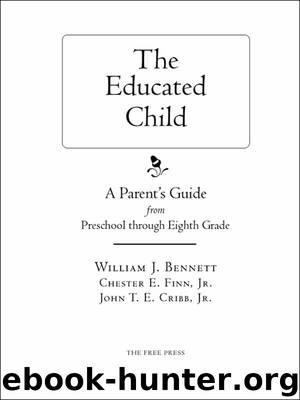The Educated Child by WILLIAM J. BENNETT & CHESTER E. FINN JR. & JOHN T. E. CRIBB JR

Author:WILLIAM J. BENNETT & CHESTER E. FINN, JR. & JOHN T. E. CRIBB, JR.
Language: eng
Format: epub
Tags: Education
Publisher: Simon & Schuster
Published: 2000-11-15T00:00:00+00:00
Web Sites
A+ Math (www.aplusmath.com)—Kids can practice their skills on a wide variety of interactive math games.
Math Archives (http://archives.math.utk.edu)—This site has links to games, instructional sites, and software reviews.
Mathematically Correct (www.mathematicallycorrect.com)—A good site for parents. Dedicated to the debate over “fuzzy math.”
SuperKids (www.superkids.com)—An annual “Best Of” software list and the ability to search for good prices make this review site worth checking out.
Through the Glass Wall (www.terc.edu/mathequity/gw/html/gwhome.html)—This site reviews software and gives tips for getting the most out of the software you buy.
Math Activities Around the House
There are all sorts of ways you can reinforce the math lessons being taught at school. You don’t need a blackboard and chalk. A math lesson can happen anytime, anywhere. If your child is learning to divide, make up simple division problems: “I have six cookies to give you, your brother, and your sister. How many cookies will each of you get?” When she first learns about place value, you might want to bundle some Popsicle sticks into sets of tens and let her practice writing the numbers for different piles of sticks (3 bundles plus 4 leftover sticks = 34). If she’s studying percentages, ask her to figure out the tip when the family eats out.
It is important to show children that this subject has practical uses in everyday living. Home, more than a school classroom, is apt to generate genuine relevance. Point out the ubiquity and utility of numbers to young children—in street addresses, phone numbers, weather reports, sports scores, etc. Make an effort to involve older children in the myriad small calculations you make as you go about chores. If the fertilizer bag says to use 20 pounds for every 5,000 square feet of lawn, ask your child to figure out the area of the yard and let you know how much to spread. Such efforts matter. They solidify knowledge, sharpen skills, and show that math is indeed important. Try a few of these ideas:
Practice mental arithmetic. As your child learns to perform different calculations, ask simple questions that require her to do math “in her head” until she is able to give quick and accurate responses. What number comes between 26 and 28? What’s half of 32? What is 6 times 7 plus 14? Count by fives, tens, odds, and evens. Count backward by twenties from 200. Practicing mental arithmetic will enable your child to work school problems more smoothly and automatically.
Make up word problems. It’s easy to think of word problems that your child can work, either in her head or with pencil and paper. “Today is September 11. Grandpa will be coming in 4 days. What day will he be here?” Or, “Your book has 116 pages. If you want to read it in one week, how many pages a day will you need to read?”
Teach about time. The concept of time is sometimes difficult to grasp and needs reinforcement at home. You’ll have to do plenty of patient explaining, and your child will need lots of practice throughout the primary years.
Download
This site does not store any files on its server. We only index and link to content provided by other sites. Please contact the content providers to delete copyright contents if any and email us, we'll remove relevant links or contents immediately.
The Art of Coaching Workbook by Elena Aguilar(50984)
Trainspotting by Irvine Welsh(21518)
Twilight of the Idols With the Antichrist and Ecce Homo by Friedrich Nietzsche(18503)
Fangirl by Rainbow Rowell(9095)
Periodization Training for Sports by Tudor Bompa(8170)
Change Your Questions, Change Your Life by Marilee Adams(7635)
This Is How You Lose Her by Junot Diaz(6794)
Asking the Right Questions: A Guide to Critical Thinking by M. Neil Browne & Stuart M. Keeley(5632)
Grit by Angela Duckworth(5521)
Red Sparrow by Jason Matthews(5390)
Paper Towns by Green John(5089)
Room 212 by Kate Stewart(5035)
Ken Follett - World without end by Ken Follett(4645)
Housekeeping by Marilynne Robinson(4344)
The Sports Rules Book by Human Kinetics(4290)
Double Down (Diary of a Wimpy Kid Book 11) by Jeff Kinney(4207)
Papillon (English) by Henri Charrière(4195)
The Motorcycle Diaries by Ernesto Che Guevara(4012)
Exercise Technique Manual for Resistance Training by National Strength & Conditioning Association(3955)
